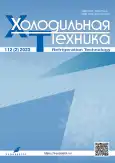Low molecular weight esters as hybrid fluids for R744 sublimation cooling circuits
- Authors: Germanus J.1, Feja S.1, Junk M.1, Rölling P.1, Kubitschke J.2
-
Affiliations:
- Institute of Air Handling and Refrigeration gGmbH
- OQ Chemicals GmbH
- Issue: Vol 112, No 2 (2023)
- Pages: 99-107
- Section: Original Study Articles
- URL: https://journal-vniispk.ru/0023-124X/article/view/259194
- DOI: https://doi.org/10.17816/RF633019
- ID: 259194
Cite item
Abstract
Up to now, for the temperature range between -50 °C and -90 °C mainly refrigerants like trifluoro methane (R23) or hydrocarbons (e.g. ethane or ethylene) are used. The phase-out of the fluorinated refrigerants with high GWP and the flammability of the hydrocarbons as refrigerants requires new technical solutions.
In the presentation, considerations are given regarding the application of the carbon dioxide phase change from solid to gaseous state for low temperature cooling. Unfortunately, the triple point of CO2 does not allow a phase change between liquid and gas below -56 °C. Thus, lower temperatures are only possible by means of sublimation. However, this requires new concepts for their technical implementation.
CO2 gives us an alternative as a non-flammable, environmentally friendly, low temperature refrigerant for a temperature range down to -80 °C, if we succeed in using the sublimation of the CO2 for cooling applications. This requires the use of new compressor lubricants, which also serve as a heat transfer fluid during the sublimation of the CO2 in a refrigeration circuit. For this reason, we looked for suitable substances that could be used. We examined some suitable compounds with regard to their thermodynamic and tribological properties as well as material compatibility.
Experimental results will be given that show the capability for the use in CO2-sublimation cooling systems.
Keywords
Full Text
##article.viewOnOriginalSite##About the authors
Joachim Germanus
Institute of Air Handling and Refrigeration gGmbH
Author for correspondence.
Email: info@ilkdresden.de
Germany, Dresden
Steffen Feja
Institute of Air Handling and Refrigeration gGmbH
Email: info@ilkdresden.de
Germany, Dresden
Margrit Junk
Institute of Air Handling and Refrigeration gGmbH
Email: info@ilkdresden.de
Germany, Dresden
Peter Rölling
Institute of Air Handling and Refrigeration gGmbH
Email: info@ilkdresden.de
Russian Federation, Dresden
Jens Kubitschke
OQ Chemicals GmbH
Email: jens.kubitschke@oq.com
Germany, Monheim am Rhein
References
- Myhre G, Shindell D, Bréon F-M, et al. Anthropogenic and Natural Radiative Forcing. In: Climate Change 2013: The Physical Science Basis. Contribution of Working Group I to the Fifth Assessment Report of the Intergovern-mental Panel on Climate Change Stocker, T.F., D. Qin, G.-K. Plattner, M. Tignor, S.K. Allen, J. Boschung, A. Nauels, Y. Xia, V. Bex and P.M. Midgley (eds.). Cambridge: Cambridge University Press, 2013. P. 659–740.
- Ciconkov R. Refrigerants: There is still no vision for sustainable solutions. International Journal of Refrigeration. 2018;86:441–448.
- Feja S, Hanzelmann C. Experimental studies of thermodynamic properties of R744-oilmixtures up to 140 °C and 150 bar. International Journal of Refrigeration. 2015;60:135–141. doi: 10.1016/j.ijrefrig.2015.07.018.
- ANSI/ASHRAE 97-2007. Sealed Glass Tube Method to Test the Chemical Stability of Materials for Use within Refrigerant Systems. ASHRAE, 2007.
- Junk M. Tribologische Charakterisierung von Öl-Kältemittel-Gemischen. Tribologie + Schmierungstechnik. 2010;57(6):49–52.
- ASTM D 7483-13a. Standard Test Method for Determination of Dynamic Viscosity and Derived Kinematic Viscosity of Liquids by Oscillating Piston Viscometer, 2013. iTeh Standards, 2020.
Supplementary files













